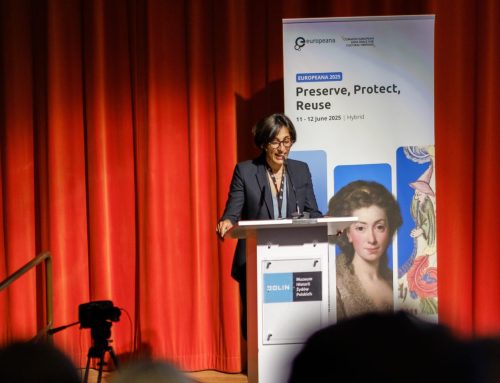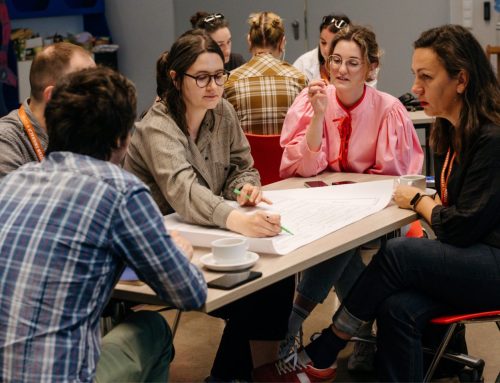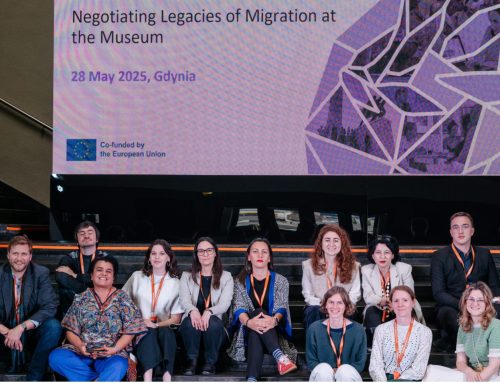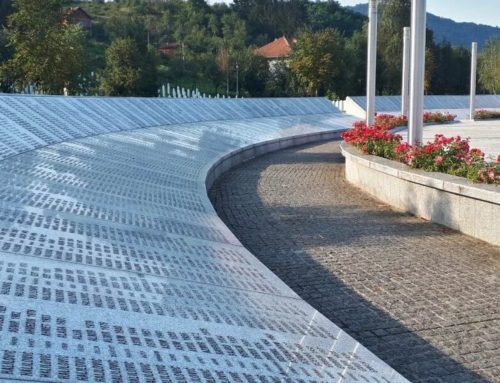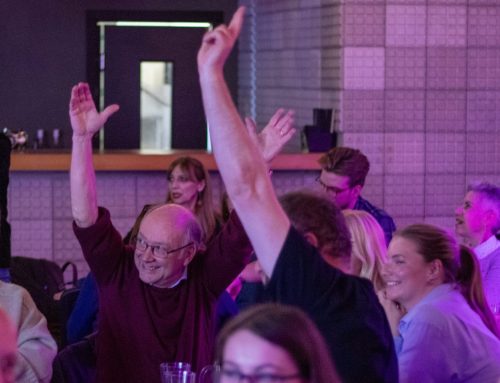There are many reasons to visit the beautiful old cities of Central Europe. In the summer of 2015 I joined a two-week tour with the non-profit organization GEEO (Global Exploration for Educators Organization). In addition to the museums of art, archeology, and history that one expects to see in Western Europe, in Central European cities one can also visit relics of the Communist era –– from Checkpoint Charlie to tours of Krakow’s Nowa Huta, a district planned to reflect communist ideals. More numerous are the museums and memorials dedicated to the memory of the victims of the Holocaust, as well as tours of old Jewish quarters, haunting reminders of the lives not lived in Berlin, Vienna, Krakow, Prague and Budapest. This is not a past to travel lightly.
Certain questions arose for me throughout this journey: What stories were the historical sights I visited designed to tell, and not tell? What happens to the narrative when a nation’s past is divided among different types of institutions, such as museums of ethnography, history and art, memorials and religious sites?Hopefully my reflections on these questions, as they relate to sights in Budapest, have bearing on how we as history teachers travel. In the second part of this essay I suggest ways that we can help students to “read” museums and monuments as critically as we hope they read historical texts.
Part I: “Reading” the Subtext: Museums and Monuments in Budapest
Like other Central European cities, Budapest has many sights devoted to the Holocaust. These include the state-funded Holocaust Memorial Centre on Páva Street, the fifth national Holocaust museum to open in the world. It was inaugurated in 2004, the same year Hungary entered the European Union. Its exhibit titled “From Deprivation of Rights to Genocide” includes the fate of the Roma as well as Jews. The magnificent Dohány Street Synagogue, the largest in Europe, belongs to the Hungarian Jewish community and was renovated in the 1990s with the help of state funds. Behind it sits the moving memorial to Raoul Wallenberg and other Righteous Among the Nations. In my visit to such moving sights, I began to wonder if such memorials serve a secondary function: to obviate the need for national history museums to incorporate centuries of Jewish life into their narratives, as well as to deflect the question of responsibility for its near extinction. If Hungary depicts itself as an ethnically homogenous nation, how does that both obscure the past, and portray its probable future?
In my visit to the National Museum of Hungary, from gallery to gallery I found a tale of the inevitable triumph of the Magyars (Hungarians). This contrasted with what I had read before arrival; the Hungarian plains as a pr
ecarious homeland for the Magyars amidst both invasions from the outside (the Turks), as well as the uncertainty of Magyar dominance in the multicultural society of the Austro-Hungarian Empire. The empire was founded in the same year Jews were extended full citizenship, in 1867. Paul Lendvai writes that in the latter half of the eighteenth century, Magyars “formed merely one-third of Hungary’s population.” The proportion of Magyars steadily mounted and by 1910 they represented more than half the population, but not by much.[i]
Of equal interest to me is the portrayal of the Hungarian past as presented at the Museum of Ethnography, across from the Hungarian Parliament Building. Earlier on this trip I had visited a similar museum in Krakow, the Ethnographic Museum at Wolnica Square. As a teacher I value these museums as a way to learn about history “from the bottom up.” In both Krakow and Budapest, permanent collections focus on peasant and folk life as celebrated in costumes, artifacts, and household interiors. The life of the “folk” is presented as a cycle of traditions following the Christian calendar, with rooms devoted to Easter and Christmas traditions. This contrasts with the French Alsatian Museum that I visited on a previous journey to Strasbourg, where in addition to Christian traditions, several rooms are devoted to Jewish life. Yet the vast majority of Jews in Hungary –– in total more than 800,000 (as counted in Hungarian records of 1944) –– lived in the countryside and small towns.[ii]
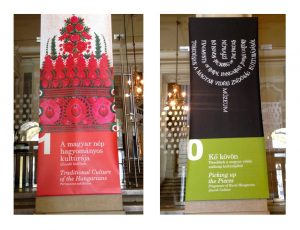 In July of 2015 when I visited the Museum of Ethnography in Budapest I saw its permanent exhibit titled “The Traditional Culture of the Hungarian People”
In July of 2015 when I visited the Museum of Ethnography in Budapest I saw its permanent exhibit titled “The Traditional Culture of the Hungarian People”
(banner to the left image) and a temporary one, “Picking Up the Pieces: Fragments of Rural Hungarian Jewish Culture.” (banner to the right image)An exhibit mounted by the museum in 2014, Dispossession and Self-Respect, focused on the Roma and other wandering craftsmen and traders essential to the maintenance
of traditional life. In his assessment of how the Museum of Ethnography portrays Hungarian society Péter Apor writes:
“Whereas, the Museum of Ethnography successfully deconstructs this image [of a homogenous society] by its thematic exhibitions demonstrating the diverse approaches to universal concepts or practices its permanent exhibit, “The Traditional Culture of the Hungarian People”, forges the rural societies of the country in one homogenous culture.”[iii]
Yet the museum itself owns the materials to give a more complete picture of Hungarian rural life. For example, according to the text accompanying the exhibit on Hungarian Jews, “The bulk of the material on display comes from the Museum of Ethnography’s own ethnography collections.”
In contrast I found that the Budapest History Museum in the Royal Palace embraced the multiethnic composition of the grand nineteenth century city, teaming with Magyars, Germans, Romanians, Slavs, Austrians, and Catholics, Protestants and Jews. Would this museum do a better job than the National History Museum in its coverage of the Holocaust? Exhibits on the twentieth century in the National History Museum do indeed include many artifacts and photographs of the Holocaust. But in the assessment of Péter Apor:
“The exhibition also discussed the Holocaust and the extermination of Jews in Hungary. Yet it occurs in the context of the representation of the general tragedy of the nation –– wartime losses, military defeat, starvation and the siege of Budapest –– emphasizing the homogeneity of experience. In general, this is a typical strategy of museums in Hungary to avoid evoking past traumas that may raise the troublesome issues of social responsibility, but emphasizing an imagery of national solidarity…” (421).[iv]
In the Budapest History Museum I found the following label, which I thought note-worthy enough to photograph:
“Under the command of Eichmann but with the active participation of the Hungarian state administration still in operation, the deportation of Hungarian Jews from the provinces to the different concentration camps all over the German Empire was launched and completed very soon. Miklós Horthy managed to prevent deportation from Budapest only, by putting military forces in action on July 6 [1944]”.
If I were to be leading a class trip to this museum I would ask students to scrutinize this text upon return. Horthy served as Regent of the Kingdom of Hungary from 1920 to October 1944, when Hitler invaded, after which the Hungarian Arrow Cross seized power. During what timeframe were Jews outside of Budapest deported (primarily to Auschwitz)? How many and what percent perished? Why did Horthy step in to save the Jews of the city? Of the Jews of Budapest, what were their fates and percentage of survival? How important was Horthy to their survival? What are the points of contention among historians who study the Horthy era, and how do different Hungarian factions view him today? Finally, is this label a just summary of Hungarian complicity in the Holocaust?
You will not learn about the controversy surrounding The House Terror on Andrássy Street from guidebooks. It opened in 2002 in the very building that served as headquarters of the fascist Hungarian Arrow Cross Party from October 1944 to 1945, and then up until 1956 as headquarters of the communist Hungarian State Protection Agency, the dreaded secret police. The museum’s director Dr. Mária Schmidt has come in for widespread criticism. Historian Randolph L. Braham writes,
“As a visionary and director of the House of Terror, Schmidt has, in the view of many historians, used this richly funded institution to denigrate and minimize the Holocaust and emphasize the crimes that had been committed during the communist era.”[v]
Other critics, like Apor believe that by conflating the Holocaust and the communist regime into one museum, the House of Horrors depicts those “horrors” as the consequence of foreign intervention, thereby relieving Hungarians of responsibility.[vi] The opening of The House of Fates, a new Holocaust museum in Budapest, has been delayed because of controversy. The Hungarian Jewish community was not initially consulted, and many question how the museum will depict Hungary’s role under the directorship of Dr. Mária Schmidt.[vii]
Where does this leave visitors to Budapest, from the casual tourist to the avid history buff? There certainly are moving tributes to those who perished in the Holocaust, and some museums celebrate the multicultural and multilingual capital that Budapest once was. Only when visitors look at a range of museums and monuments does it become apparent that the country remains deeply divided in its interpretation of its past.
Part II: In the classroom: Thinking Critically about Museums
Today it’s ever-easier for students in one country to visit the historical sights in another EU nation. Yet all too often students think of sight seeing as a passive activity, one of viewing and listening. How then can we help students to use their critical thinking skills not only in the classroom, but when they move outside of it? Learners should be reminded that nationalism and the desire to legitimize the nation-state through prestigious collections have long been joint enterprises. Before a visit to any given museum, students should read background information about its history as an institution. When and why it was founded, who donated to it, and how were its collections acquired? Are there remaining controversies about who is the rightful owner of art or artifacts? Do the Parthenon sculptures now in the British Museum belong in the United Kingdom or Greece? Were any works of art seized from Jewish families during World War II?
In a recent article in the New York Times, Holland Cotter writes,
“Art museums are political, whether they want to be or not. Through the objects they acquire and exhibit, and in the ways they interpret those objects — what they say about them, what they don’t say — the institutions make statements about the relative value of cultures, meaning groups of people, and about who is important and who is not.”[viii]
Providing students with a map of the galleries before they visit helps them to analyze the subtext of what a museum says to its public. For example, the Metropolitan Museum of Art in New York City has magnificent collections of Asian and African art. But on entering the Great Hall, the Greek and Roman galleries are on your left, the Egyptian galleries (far from the African galleries) are on your right, and dead center is the stairway leading to the European art collection. Thus European civilization appears to be the apogee, with roots in what we call the classical world and Ancient Egypt. The Metropolitan and Louvre museums offer online maps that students can study, even if they do not visit. The Met even offers an on-line history of each collection.
How are galleries titled? When the Metropolitan re-opened its Islamic Art galleries it renamed them, “The Art of the Arab Lands, Turkey, Iran, Central Asia, and Later South Asia.” Holland Cotter was quick to see the new title’s import:
“Rather than presenting Islamic art as the product of a religiously driven mono culture encompassing centuries and continents, the Met is now — far more realistically — approaching it as a varied, changing, largely secular phenomenon.”[ix]
How do history museums divide their galleries into chronological eras? Students can compare how the national museums of two neighboring countries periodize and title displays on similar topics. For example, the penultimate exhibit in the Hungarian National Museum reads: “From the Success of Revision to German and Russian Occupation (1938-1945).” In 1938 Hitler took over Austria, a series of anti-Jewish laws were passed under Miklós Horthy, and Hungary regained some of the territory it lost in World War I. But why did museum curators begin with 1938? With what other date might this gallery have begun? Hungary was an independent Axis power from 1940 until Hitler invaded in 1944. Students can debate whether a better title would reflect this fact. They can suggest new ways to periodize a set of galleries and title them, and vote on the best one.
Similar activities apply to many monuments. Who wanted the monument and to what purpose: to glorify a leader, to honor the dead, to privilege some groups over others? When was it built ––and why then? How was it funded, and did anyone object?
Finally, how does the portrayal of the past reflect the present? Hungary, as well as many other European nations, is confronting an immigration crisis as well as controversy about its treatment of Roma. What kind of country it wants to become can be seen as a reflection of the way it portrays its past.
 About the author
About the author
Joan Brodsky Schur taught history and world literature in Greenwich Village, New York City for over twenty-five years. Her articles have appeared in Social Education, the journal of the National Council for the Social Studies (USA). Her on-line lessons appear on the websites of the National Archives and PBS (Public Broadcasting Service). Joan worked with Jonathan Even-Zohar writing curricula for Our Shared Past in the Mediterranean.com. She also contributed to the world history site The Indian Ocean in World History.com. Currently she serves as Social Studies Consultant to the City and Country School, NYC.
————————————————————————————————————————————————————————————-
[i] Paul Lendvai, The Hungarians: A Thousand Years of Victory in Defeat (Princeton, New Jersey: Princeton University Press, 2003) 3.
[ii] John Lukacs, Budapest 1900: A Historical Portrait of a City & its Culture (New York: Grove Press, 1988) 96.
[iii] Péter Apor, “National Museums in Hungary” in Building National Museums in Europe 1750-2010 (Conference proceedings of European National Museums: Identity Politics, the Uses of the Past and the European Citizen, Bologna 28-30 April, 2011.) 422. Accessed on line at Linköping University Press http://www.ep.liu.se/ecp/064/017/ecp64017.pdf
[iv] Apor, 421
[v] Randolph L. Braham, “Hungary: The Assault On the Historical Memory of the Holocaust.” Accessed at the United States Holocaust Memorial Museum at https://www.ushmm.org/m/pdfs/20140318-Holocaust-in-Hungary-Braham-Assault-on-Historical-Memory.pdf (28)
[vi] Apor, 422
[vii] For articles on the House of Fates see “House of Fates: Mária Schmidt versus János Lázár” at The Hungarian Spectrum http://hungarianspectrum.org/tag/gusztav-zoltai/.
About the Monument to the 70th anniversary of Nazi occupation see, “Controversial monument divides Hungarians, angers Jewish community”, July 23, 2014. http://www.euractiv.com/section/central-europe/news/controversial-monument-divides-hungarians-angers-jewish-community/
[viii] “Holland Cotter, “Placement Is Politics in Brooklyn Museum Reinstallation”, The New York Times, May 19, 2016. http://www.nytimes.com/2016/05/20/arts/design/placement-is-politics-in-brooklyn-museum-reinstallation.html
[ix] Holland Cotter, “A Cosmopolitan Trove of Exotic Beauty, The New York Times, October 27, 2011. http://www.nytimes.com/2011/10/28/arts/design/the-mets-new-islamic-galleries-dreview.html?_r=0



